24 found, showing page 1 of 2
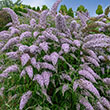
The 'Grand Cascade' is truly a sight to behold, producing massive clusters of extra large lavender blooms that can get up to 4 inches thick. Blooms are fragrant and attract many beneficial pollinators, including many different varieties of butterflies. Can get 5-7' tall and 6-8' wide. A stunning specimen for any garden space.
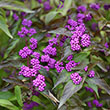
The 'Amethyst' beautyberry produces light lavender blooms in early summer that turn to amethyst-colored berries in mid-summer. Showy, attractive berries will persist all the way into October. This compact variety grows 3-4' tall and 4-5' wide and grows best in a full sun environment.
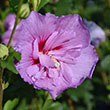
The 'Lavender Chiffon' produces ruffled, lavender-pink blooms that appear in late summer and persist into fall. This variety will reach 8-12' tall and 4-6' wide.

Glossy, dark green foliage creates the perfect canvas for the 'Muskogee's' lavender-pink flowers in the summer. Red-orange fall color in the fall is followed by outstanding, brownish-gray exfoliating bark in the winter. Grows 10-15' tall and 8-12' wide.
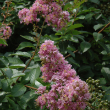
Height: 20 feet
Spread: 15 feet
Sunlight: full sun, partial shade
Hardiness Zone: 6b
Other Names: Crape Myrtle, Crepe Myrtle
Description:
This attractive ornamental shrub or small tree produces volumes of light lavender-pink frilly blooms in summer, followed by vibrant red fall foliage; captivating focal point for the garden or border
Ornamental Features:
Muskogee Crape Myrtle is covered in stunning panicles of lavender frilly flowers with pink overtones at the ends of the branches from early to late summer. It has attractive dark green deciduous foliage which emerges coppery-bronze in spring. The oval leaves are highly ornamental and turn red in fall.
Landscape Attributes:
Muskogee Crape Myrtle is a dense multi-stemmed deciduous tree with a more or less rounded form. Its relatively fine texture sets it apart from other landscape plants with less refined foliage.
This is a relatively low maintenance tree, and is best pruned in late winter once the threat of extreme cold has passed. It has no significant negative characteristics.
Muskogee Crape Myrtle is recommended for the following landscape applications:
- Accent
- Mass Planting
- Hedges/Screening
- General Garden Use
Planting & Growing:
Muskogee Crape Myrtle will grow to be about 20 feet tall at maturity, with a spread of 15 feet. It has a low canopy with a typical clearance of 3 feet from the ground, and is suitable for planting under power lines. It grows at a fast rate, and under ideal conditions can be expected to live for approximately 20 years.
This tree does best in full sun to partial shade. It prefers to grow in average to moist conditions, and shouldn't be allowed to dry out. It is very fussy about its soil conditions and must have rich, acidic soils to ensure success, and is subject to chlorosis (yellowing) of the foliage in alkaline soils. It is highly tolerant of urban pollution and will even thrive in inner city environments. This particular variety is an interspecific hybrid.
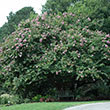
Glossy, dark green foliage creates the perfect canvas for the 'Muskogee's' lavender-pink flowers in the summer. Red-orange fall color in the fall is followed by outstanding, brownish-gray exfoliating bark in the winter. Grows 10-15' tall and 8-12' wide.
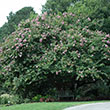
Glossy, dark green foliage creates the perfect canvas for the 'Muskogee's' lavender-pink flowers in the summer. Red-orange fall color in the fall is followed by outstanding, brownish-gray exfoliating bark in the winter. Grows 10-15' tall and 8-12' wide.
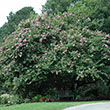
Glossy, dark green foliage creates the perfect canvas for the 'Muskogee's' lavender-pink flowers in the summer. Red-orange fall color in the fall is followed by outstanding, brownish-gray exfoliating bark in the winter. Grows 10-15' tall and 8-12' wide.
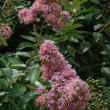
Height: 20 feet
Spread: 15 feet
Sunlight: full sun, partial shade
Hardiness Zone: 6b
Other Names: Crape Myrtle, Crepe Myrtle
Description:
This attractive ornamental shrub or small tree produces volumes of light lavender-pink frilly blooms in summer, followed by vibrant red fall foliage; captivating focal point for the garden or border
Ornamental Features:
Muskogee Crape Myrtle is covered in stunning panicles of lavender frilly flowers with pink overtones at the ends of the branches from early to late summer. It has attractive dark green deciduous foliage which emerges coppery-bronze in spring. The oval leaves are highly ornamental and turn red in fall.
Landscape Attributes:
Muskogee Crape Myrtle is a dense multi-stemmed deciduous tree with a more or less rounded form. Its relatively fine texture sets it apart from other landscape plants with less refined foliage.
This is a relatively low maintenance tree, and is best pruned in late winter once the threat of extreme cold has passed. It has no significant negative characteristics.
Muskogee Crape Myrtle is recommended for the following landscape applications:
- Accent
- Mass Planting
- Hedges/Screening
- General Garden Use
Planting & Growing:
Muskogee Crape Myrtle will grow to be about 20 feet tall at maturity, with a spread of 15 feet. It has a low canopy with a typical clearance of 3 feet from the ground, and is suitable for planting under power lines. It grows at a fast rate, and under ideal conditions can be expected to live for approximately 20 years.
This tree does best in full sun to partial shade. It prefers to grow in average to moist conditions, and shouldn't be allowed to dry out. It is very fussy about its soil conditions and must have rich, acidic soils to ensure success, and is subject to chlorosis (yellowing) of the foliage in alkaline soils. It is highly tolerant of urban pollution and will even thrive in inner city environments. This particular variety is an interspecific hybrid.
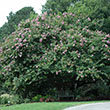
Glossy, dark green foliage creates the perfect canvas for the 'Muskogee's' lavender-pink flowers in the summer. Red-orange fall color in the fall is followed by outstanding, brownish-gray exfoliating bark in the winter. Grows 10-15' tall and 8-12' wide.
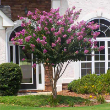
Glossy, dark green foliage creates the perfect canvas for the 'Muskogee's' lavender-pink flowers in the summer. Red-orange fall color in the fall is followed by outstanding, brownish-gray exfoliating bark in the winter. Grows 10-15' tall and 8-12' wide.

Glossy, dark green foliage creates the perfect canvas for the 'Muskogee's' lavender-pink flowers in the summer. Red-orange fall color in the fall is followed by outstanding, brownish-gray exfoliating bark in the winter. Grows 10-15' tall and 8-12' wide.
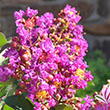
Princess Jaden' is a dwarf variety that will quickly reach 1-2' tall and wide and is perfect for small garden spaces. It produces lavender blooms that persist through the summer.
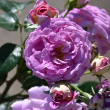
Height: 5 feet
Spread: 4 feet
Sunlight: full sun partial shade
Hardiness Zone: 4a
Group/Class: Floribunda Rose
Brand: Weeks Roses
Description:
Exciting lilac pink blooms that fade to lavender blue with a cream reverse; blooms constantly throughout the season and will make a stunning visual impact along walkways, borders, or in the garden; outstanding disease resistance
Ornamental Features:
Arctic Blue Rose features showy fragrant lilac purple flowers with gold eyes and a creamy white reverse at the ends of the branches from late spring to mid fall. The flowers are excellent for cutting. It has forest green deciduous foliage. The glossy oval compound leaves do not develop any appreciable fall color.
Landscape Attributes:
Arctic Blue Rose is a multi-stemmed deciduous shrub with an upright spreading habit of growth. Its average texture blends into the landscape, but can be balanced by one or two finer or coarser trees or shrubs for an effective composition.
This shrub will require occasional maintenance and upkeep, and is best pruned in late winter once the threat of extreme cold has passed. It is a good choice for attracting bees to your yard. Gardeners should be aware of the following characteristic(s) that may warrant special consideration:
-Spiny
Arctic Blue Rose is recommended for the following landscape applications:
- Mass Planting
- Hedges/Screening
- General Garden Use
Planting & Growing:
Arctic Blue Rose will grow to be about 5 feet tall at maturity, with a spread of 4 feet. It tends to fill out right to the ground and therefore doesn't necessarily require facer plants in front, and is suitable for planting under power lines. It grows at a fast rate, and under ideal conditions can be expected to live for approximately 30 years.
This shrub does best in full sun to partial shade. It does best in average to evenly moist conditions, but will not tolerate standing water. It is not particular as to soil type or pH. It is highly tolerant of urban pollution and will even thrive in inner city environments. This particular variety is an interspecific hybrid.
24 found, showing page 1 of 2